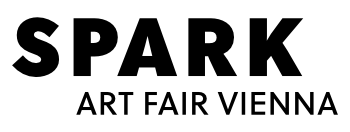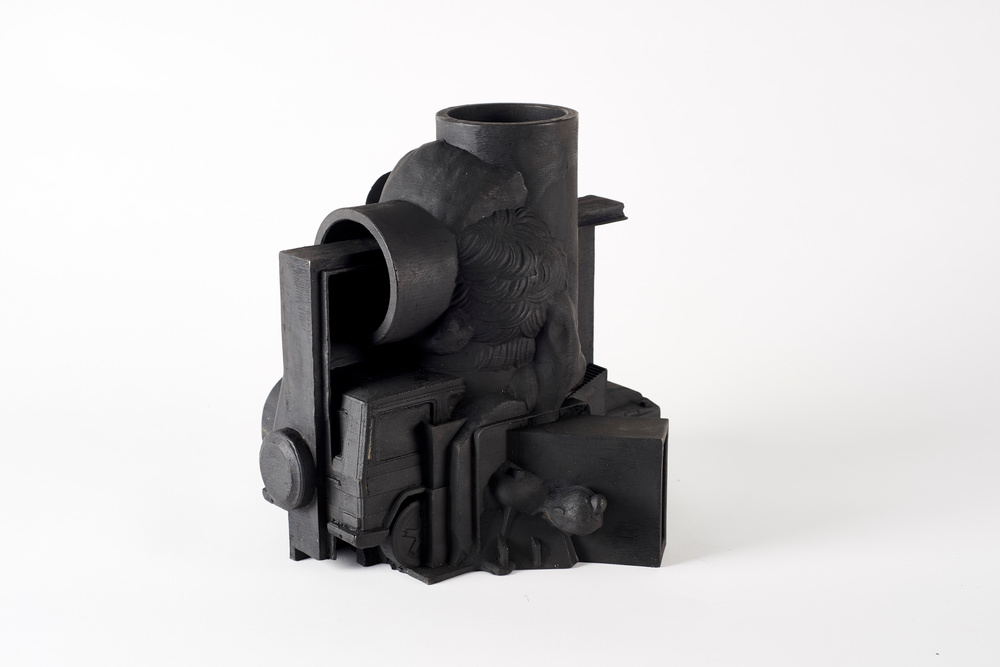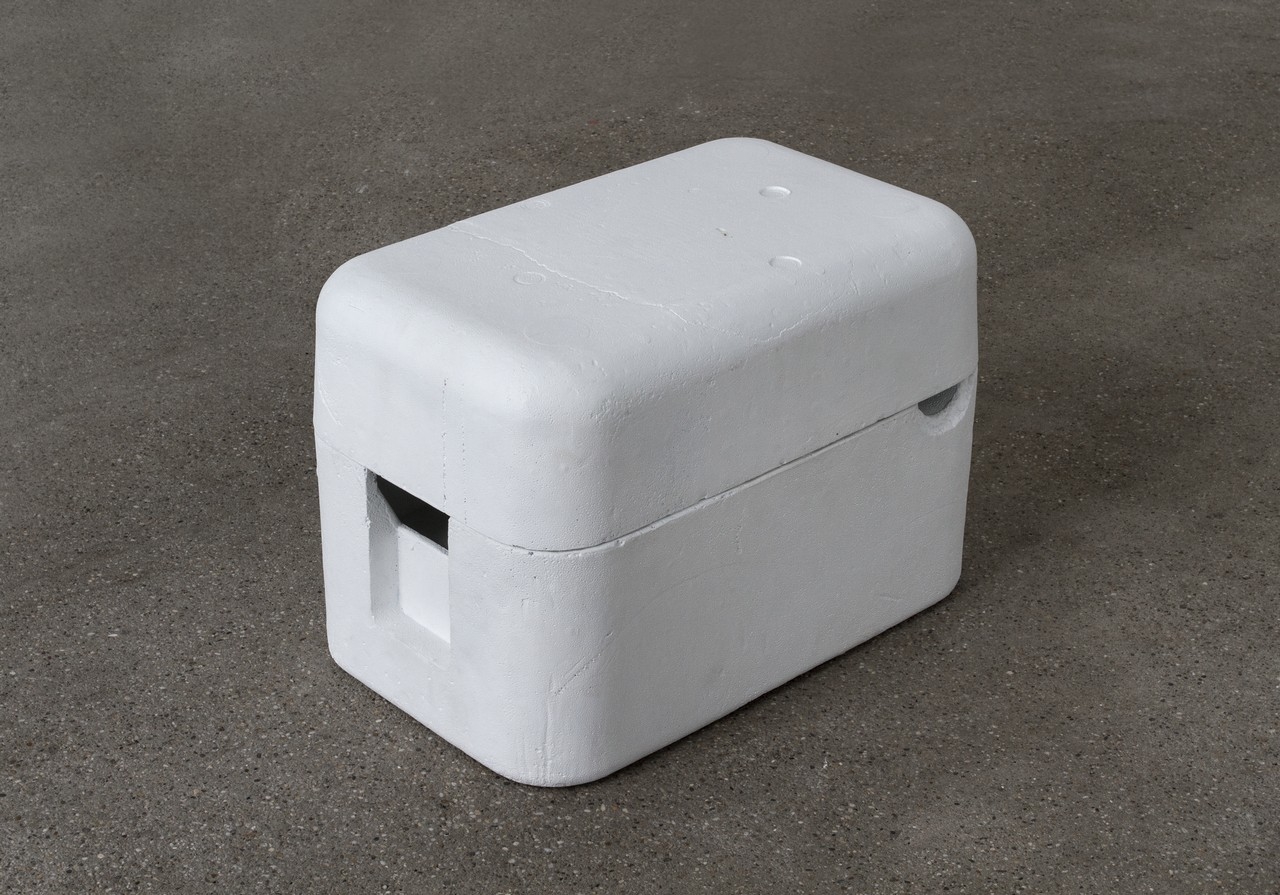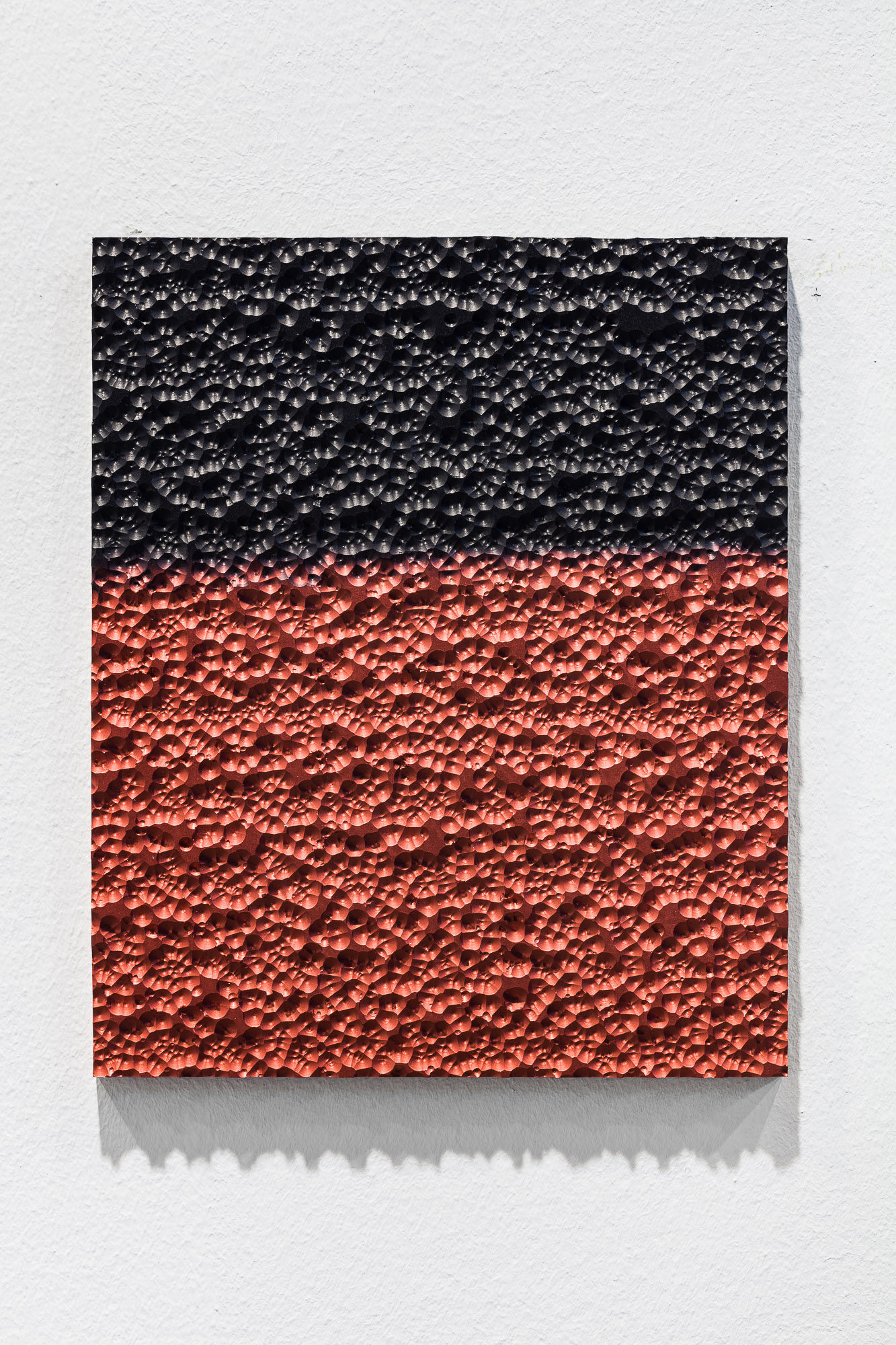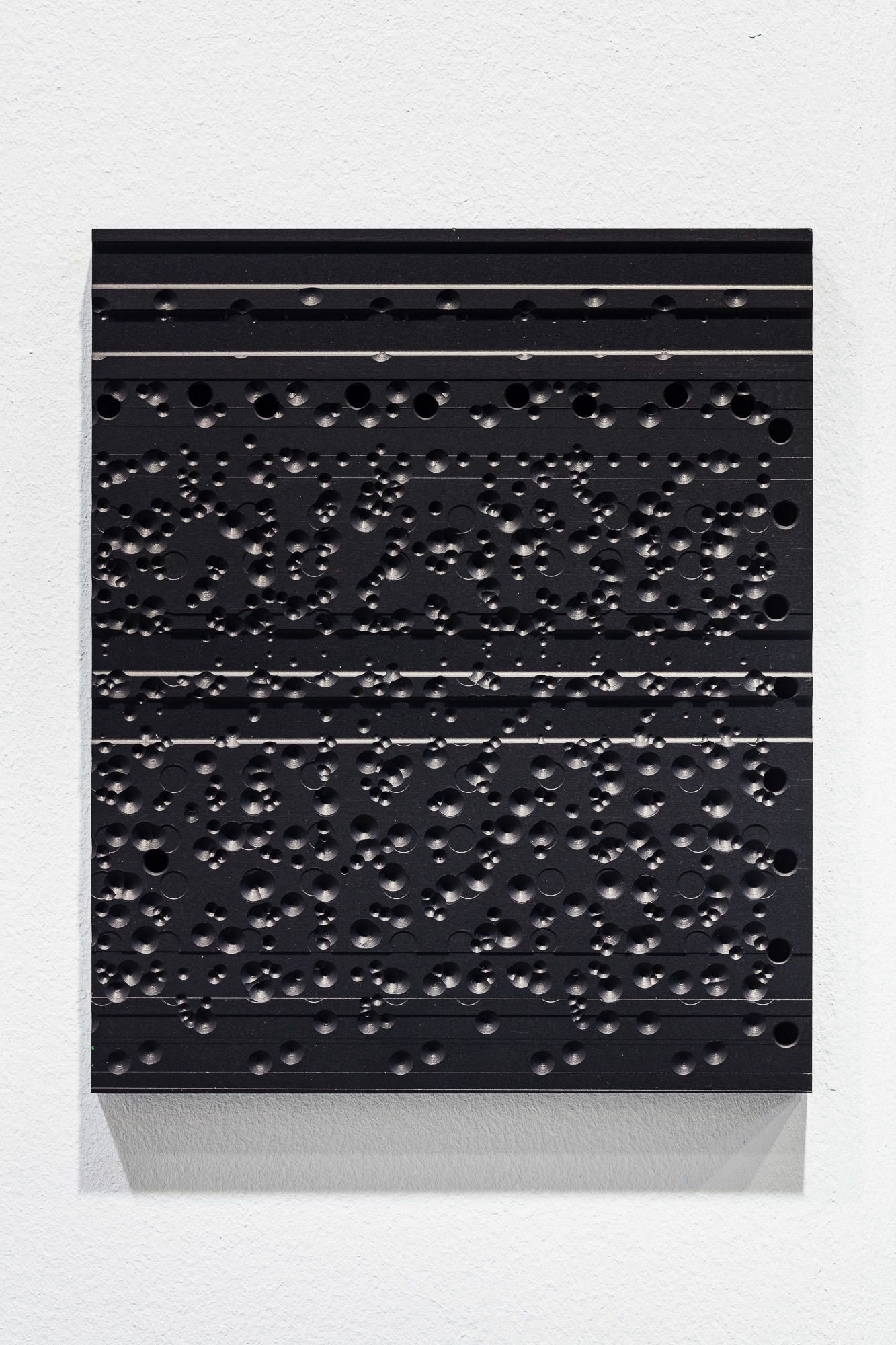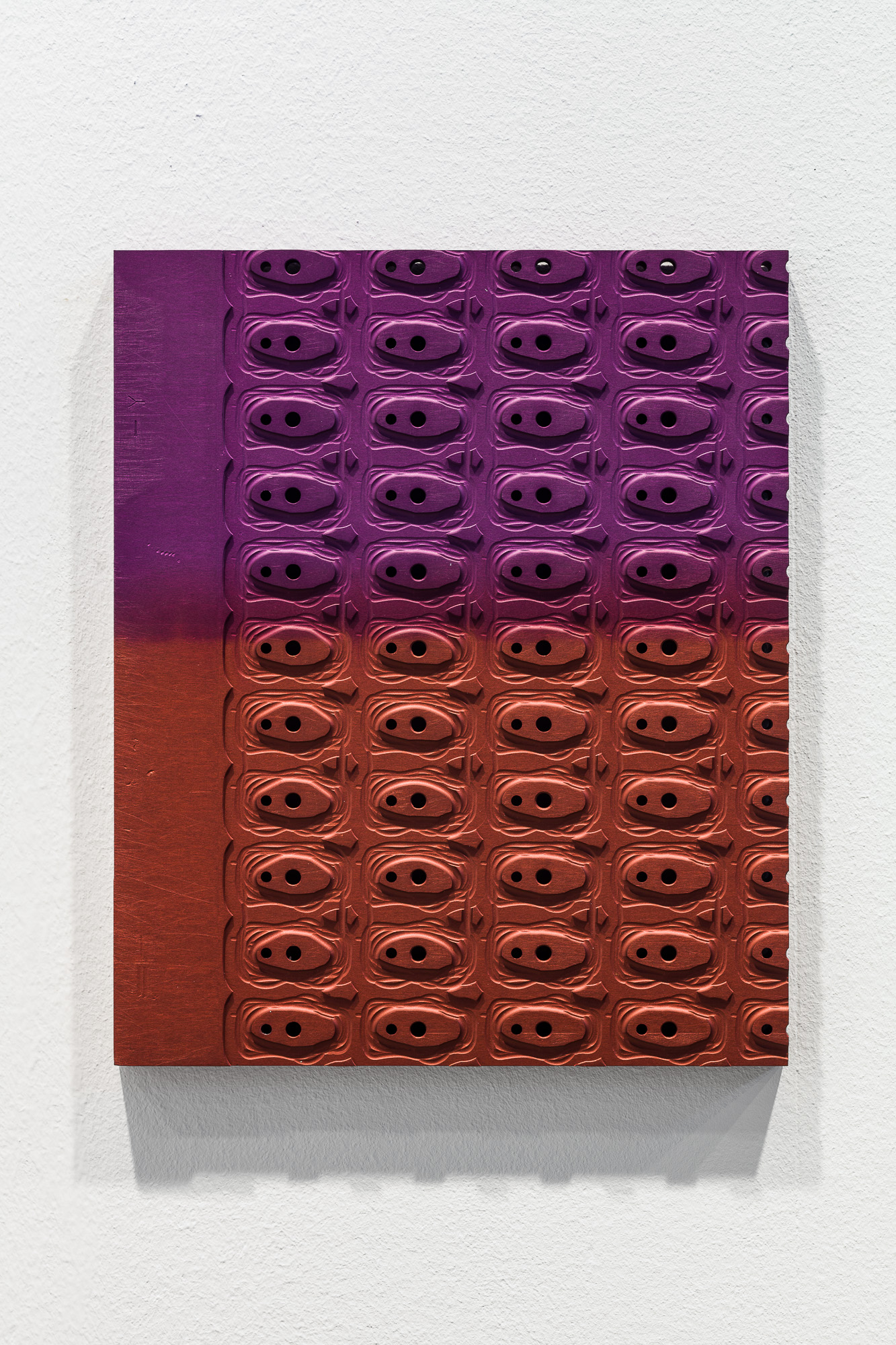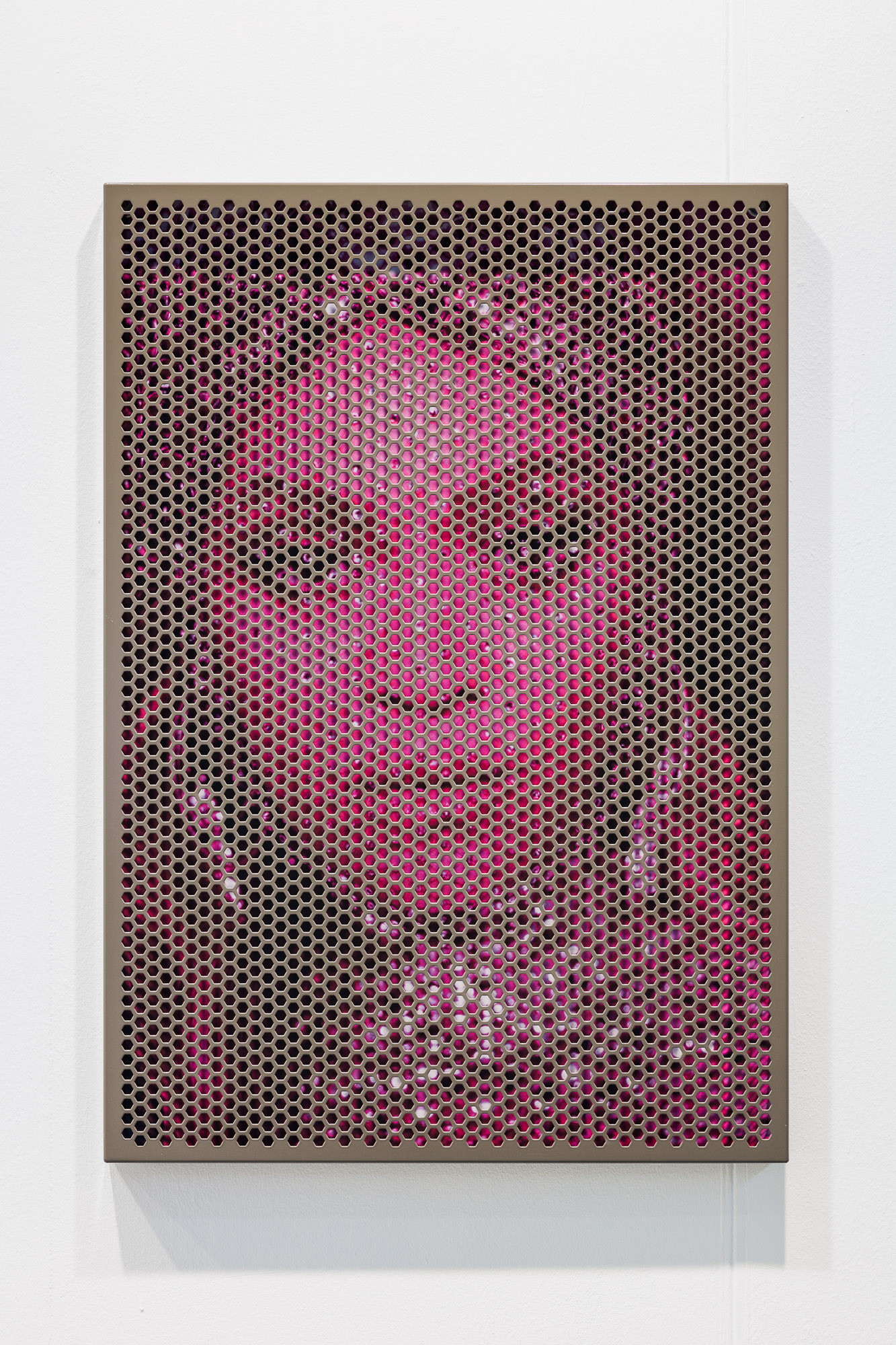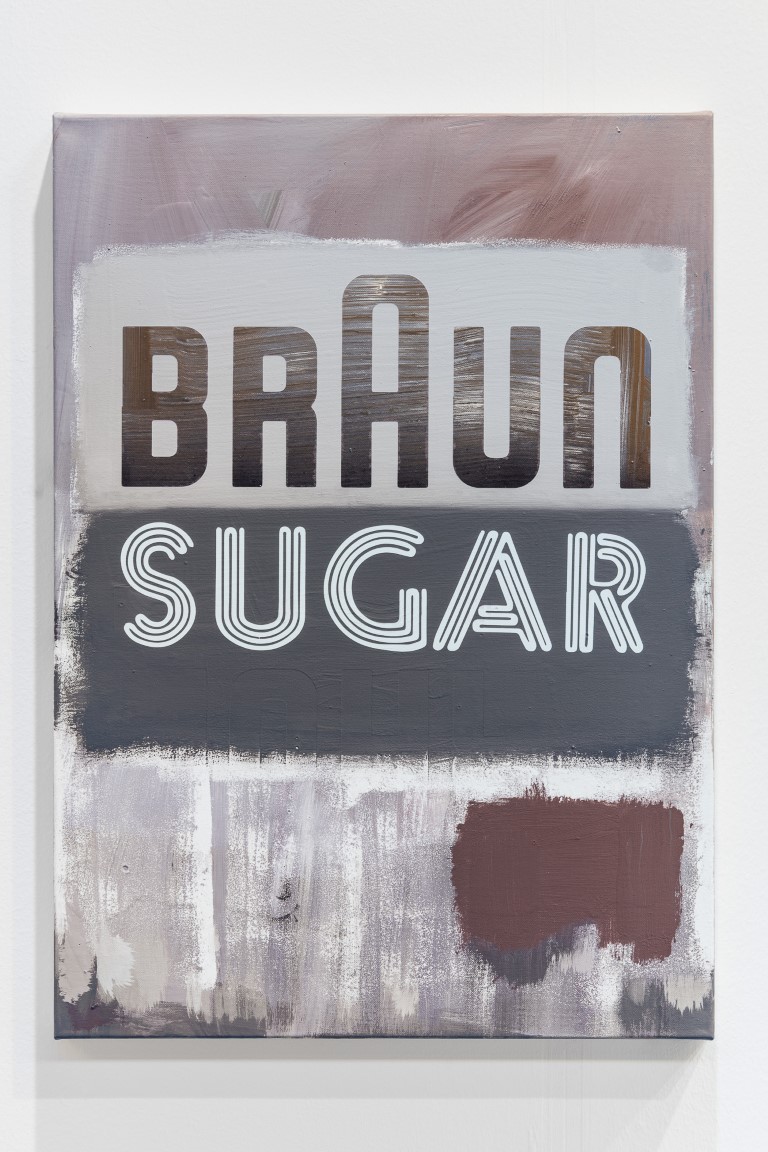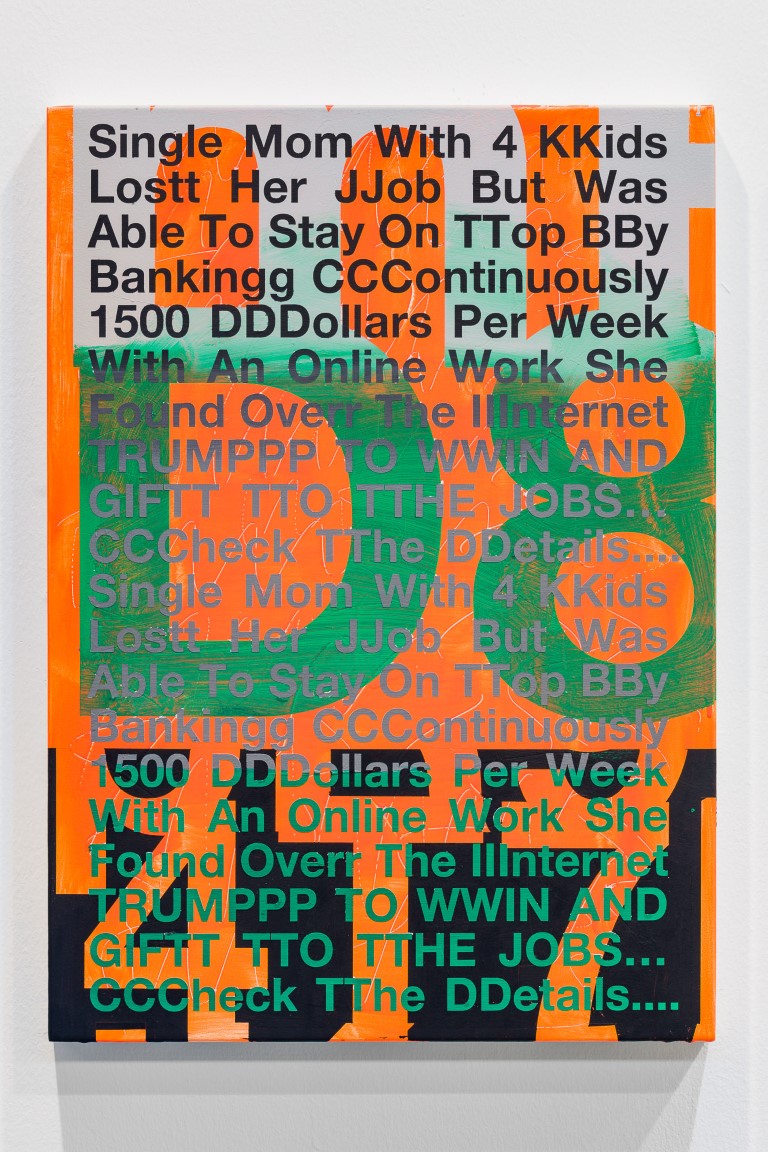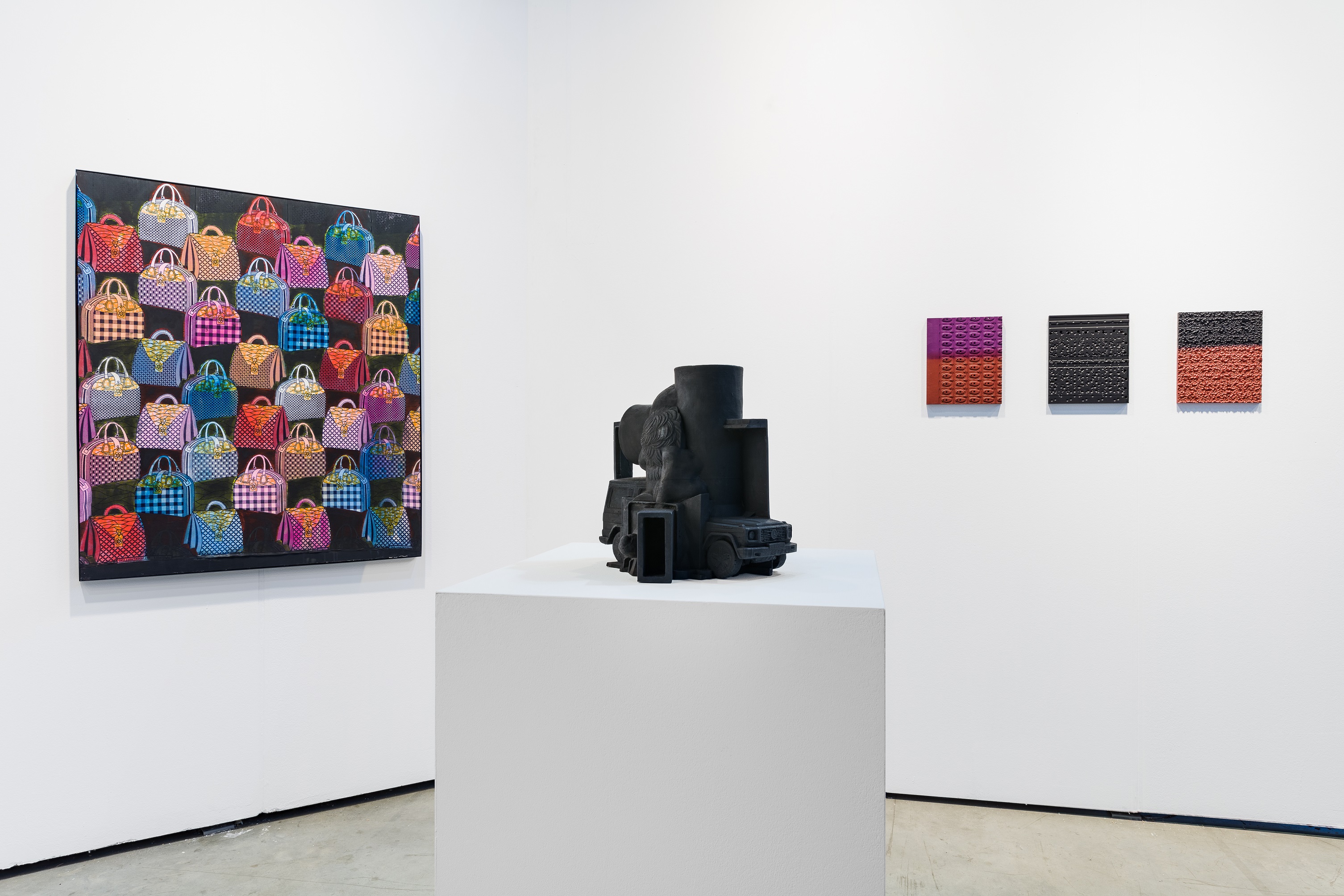Galerie Elisabeth & Klaus Thoman
Johannes Wohnseifer
Wohnseifer uses various materials with different histories and form structures. He uses them in unusual contexts, such as aluminum.
Aluminum is a material that stands for an almost brutal efficiency. It is rust-resistant and is used equally for airplanes, cars, house facades, bombs and window frames. So it contains metaphors for movement and speed as well as lightweight construction (efficiency) and destruction.
For Wohnseifer, the applied paint is part of the quality of the material as a finished work of art.
In the work ‚Michelle’s handbags‘ Johannes Wohnseifer takes use of a cloth, to be exact an African Wax Print cotton, as the primary material. The garment shows a pattern of handbags as a motif, which is said to be the one Michelle Obama wore to her first official visit to Africa as First Lady. The artist bought the garment online at an official website selling the material, lined it on wood and overpainted it.
The form structure of his ‚Apple G4 Cube‘ the artist sums up this way:
„I found that the design of the outer packaging made of Styrofoam for the Apple devices of that time was very carefully thought out, and I could see a high commitment to form. To me, the sleeves seemed like ghosts of the devices.
I then transformed them into aluminum sculptures using full-mold casting and painted them white according to the original. The devices to the packaging are now technically obsolete or no longer functional. The former packaging continues to have an effect as sculpture and afterimage.“
Wohnseifer also invented logos and subversive messages that borrow from corporate branding jargon, loaded cultural symbols, and political propaganda. Working within an array of media including collage, painting, and photography, he explores themes as war, death and time.
Biography
Johannes Wohnseifer * 1967 in Cologne, currently lives and works in Cologne and Erftstadt and teaches as professor at the Academy of Media Arts in Cologne. His video works, photographs, sculptures and installations contain many references to design, art history and are as well denoted to an analysis of our everyday life, which has been shaped by mass media, in which the hierarchies of the intellectual and the undemanding have become obsolete. Painting, a focal point of his oeuvre, often contains multi-layered, historical references to society, economy, design and pop. It takes up everyday culture determined by mass media and can be understood as a contemporary answer to Pop Art of the 1960s. The artist’s works are represented in many international collections, including Saatchi Gallery, London; Boros Collection, Berlin; Museum Ludwig, Cologne and the Collection of Contemporary Art of the Federal Republic of Germanyin Berlin. The artist is represented by Galerie Elisabeth & Klaus Thoman Innsbruck/Vienna, Galerie Gisela Capitain, Cologne, Johann König, Berlin and Casey Kaplan, New York, Linn Lühn, Düsseldorf and Meliksetian I Briggs, Los Angeles.
Galerie Elisabeth & Klaus Thoman
Founded in 1977 in Innsbruck, Galerie Elisabeth & Klaus Thoman has been working with important and internationally renowned contemporary artists from Austria, including Bruno Gironcoli, Hermann Nitsch, Walter Pichler, Arnulf Rainer and Franz West. In the 80s the gallery started working with a younger generation of painters – Siegfried Anzinger, Herbert Brandl, Erwin Bohatsch and Gunter Damisch – that were just leaving the academies, later known as “Neue Wilde”. Artist from different media and the neighbouring countries joined the gallery in the 90s and early 2000s: Éva Bodnár, Maria Brunner, Thomas Feuerstein, Michael Kienzer, Florin Kompatscher and Peter Sandbichler.
The gallery profile is continuously complemented with significant international positions, always taken in a cultural context: John M Armleder, Günther Förg, Jürgen Klauke and Tal R; as well as our latest international collaborations: Mai-Thu Perret and Johannes Wohnseifer. The focus remains to work with artists long-term and to accompany them through their career. In 2011, the gallery opened a large-scale dependance in Vienna’s first district. While Elisabeth and Klaus Thoman have been operating as the gallerists for already 40 years, in 2020 a younger generation of directors joined their team, consisting of Maximilian Thoman and Eva Oberhofer. They are now taking care of the space in Vienna as well as continuously adding new positions to the gallery’s artist list, like Julia Haugeneder and Johannes Kofler.
Furthermore a dialogue with emerging artists was founded with the projectspace tart.vienna, that regularly hosts exhibitions for external artists in the gallery’s Seitengalerie.

+4315120840
Maximilian Thoman
06643508847
Johannes Wohnseifer
Wohnseifer uses various materials with different histories and form structures. He uses them in unusual contexts, such as aluminum.
Aluminum is a material that stands for an almost brutal efficiency. It is rust-resistant and is used equally for airplanes, cars, house facades, bombs and window frames. So it contains metaphors for movement and speed as well as lightweight construction (efficiency) and destruction.
For Wohnseifer, the applied paint is part of the quality of the material as a finished work of art.
In the work ‚Michelle’s handbags‘ Johannes Wohnseifer takes use of a cloth, to be exact an African Wax Print cotton, as the primary material. The garment shows a pattern of handbags as a motif, which is said to be the one Michelle Obama wore to her first official visit to Africa as First Lady. The artist bought the garment online at an official website selling the material, lined it on wood and overpainted it.
The form structure of his ‚Apple G4 Cube‘ the artist sums up this way:
„I found that the design of the outer packaging made of Styrofoam for the Apple devices of that time was very carefully thought out, and I could see a high commitment to form. To me, the sleeves seemed like ghosts of the devices.
I then transformed them into aluminum sculptures using full-mold casting and painted them white according to the original. The devices to the packaging are now technically obsolete or no longer functional. The former packaging continues to have an effect as sculpture and afterimage.“
Wohnseifer also invented logos and subversive messages that borrow from corporate branding jargon, loaded cultural symbols, and political propaganda. Working within an array of media including collage, painting, and photography, he explores themes as war, death and time.
Biography
Johannes Wohnseifer * 1967 in Cologne, currently lives and works in Cologne and Erftstadt and teaches as professor at the Academy of Media Arts in Cologne. His video works, photographs, sculptures and installations contain many references to design, art history and are as well denoted to an analysis of our everyday life, which has been shaped by mass media, in which the hierarchies of the intellectual and the undemanding have become obsolete. Painting, a focal point of his oeuvre, often contains multi-layered, historical references to society, economy, design and pop. It takes up everyday culture determined by mass media and can be understood as a contemporary answer to Pop Art of the 1960s. The artist’s works are represented in many international collections, including Saatchi Gallery, London; Boros Collection, Berlin; Museum Ludwig, Cologne and the Collection of Contemporary Art of the Federal Republic of Germanyin Berlin. The artist is represented by Galerie Elisabeth & Klaus Thoman Innsbruck/Vienna, Galerie Gisela Capitain, Cologne, Johann König, Berlin and Casey Kaplan, New York, Linn Lühn, Düsseldorf and Meliksetian I Briggs, Los Angeles.
Galerie Elisabeth & Klaus Thoman
Founded in 1977 in Innsbruck, Galerie Elisabeth & Klaus Thoman has been working with important and internationally renowned contemporary artists from Austria, including Bruno Gironcoli, Hermann Nitsch, Walter Pichler, Arnulf Rainer and Franz West. In the 80s the gallery started working with a younger generation of painters – Siegfried Anzinger, Herbert Brandl, Erwin Bohatsch and Gunter Damisch – that were just leaving the academies, later known as “Neue Wilde”. Artist from different media and the neighbouring countries joined the gallery in the 90s and early 2000s: Éva Bodnár, Maria Brunner, Thomas Feuerstein, Michael Kienzer, Florin Kompatscher and Peter Sandbichler.
The gallery profile is continuously complemented with significant international positions, always taken in a cultural context: John M Armleder, Günther Förg, Jürgen Klauke and Tal R; as well as our latest international collaborations: Mai-Thu Perret and Johannes Wohnseifer. The focus remains to work with artists long-term and to accompany them through their career. In 2011, the gallery opened a large-scale dependance in Vienna’s first district. While Elisabeth and Klaus Thoman have been operating as the gallerists for already 40 years, in 2020 a younger generation of directors joined their team, consisting of Maximilian Thoman and Eva Oberhofer. They are now taking care of the space in Vienna as well as continuously adding new positions to the gallery’s artist list, like Julia Haugeneder and Johannes Kofler.
Furthermore a dialogue with emerging artists was founded with the projectspace tart.vienna, that regularly hosts exhibitions for external artists in the gallery’s Seitengalerie.
ABOUT Johannes Wohnseifer

